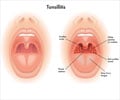A study has found that a tonsillectomy and adenoidectomy is the best way for improving the life of children who are suffering from obstructive sleep apnea.
The study conducted by a Saint Louis University found that the two surgeries provide a huge relief and also successfully solved the sleep problems of 80 to 90 percent of the children.A survey was conducted on how children with different types of OSA fared before and after the surgery, by studying their sleep patterns preoperative and postoperative.
The children’s age and ethnicity were also taken into consideration as being potential factors, which could affect the diagnosis of OSA and impact of the surgery.
It was found that children who suffered from OSA would stop breathing normally throughout the night and begin to snore very loudly.
In children with normal weight, it was found that the condition was caused by the enlargement of the tonsils and adenoids, which in turn caused the upper airway to collapse during sleep, disrupting normal breathing.
Ron Mitchell, M.D., professor of paediatric otolaryngology at Saint Louis University and the study’s author, commented on how surgery can help better the life of children suffering from OSA.
Advertisement
“Our study has shown that surgery can have a profound positive effect on children’s lives,” he added.
Advertisement
Surgery was carried out on 79 children, and all showed significant improvement, with just a few having persistent OSA. The study also found that the success of the surgery depended on the severity of the OSA before the operation.
The results of the surgery was described as there being less than five incidents of interrupted breathing throughout the course of a night.
Children, who had mild preoperative OSA, had their OSA resolved with five to nine incidents per night. For children with moderate preoperative OSA they had 10-19 incidents per night.
About 88 percent children experienced resolution, while 64 percent of the children with severe preoperative OSA had 20 incidents or more, but experienced resolution.
“The results of the surgery were dramatic, even for children who had persistent OSA,” Mitchell said.
“To go from having 40 or more incidents of interrupted breathing in a night to having only five or six – that is a pretty remarkable improvement in their sleep that leads to a dramatic improvement in quality of life,” he stated.
OSA, which causes one not to have a sound sleep, can have a negative affect on the children’s behaviour, health, growth, attention, memory and classroom performance. OSA has also been linked to lower childhood IQ scores.
“Not all children with sleep problems have behavioural issues before surgery, and not all behavioural problems resolve post-surgery,” Dr. Mitchell emphasized.
“Children who score way outside normal parameters on behavioural measures benefit the most from surgery,” he added.
Mitchell’s research also showed the importance of postoperative follow up, especially for children who had severe OSA.
“Even though OSA resolved in the overwhelming majority of children after the surgery, it is still crucial to identify and treat children with persistent OSA,” Mitchell said.
“Otherwise these children will continue to experience the health, behavioral and learning problems associated with OSA,” he added.
Children who are obese and children with Down’s syndrome or other genetic disorders that affect the craniofacial anatomy were excluded from the study because the rate of OSA is known to be higher.
The study was published in a recent issue of The Laryngoscope.
Source-ANI
SRM/L











